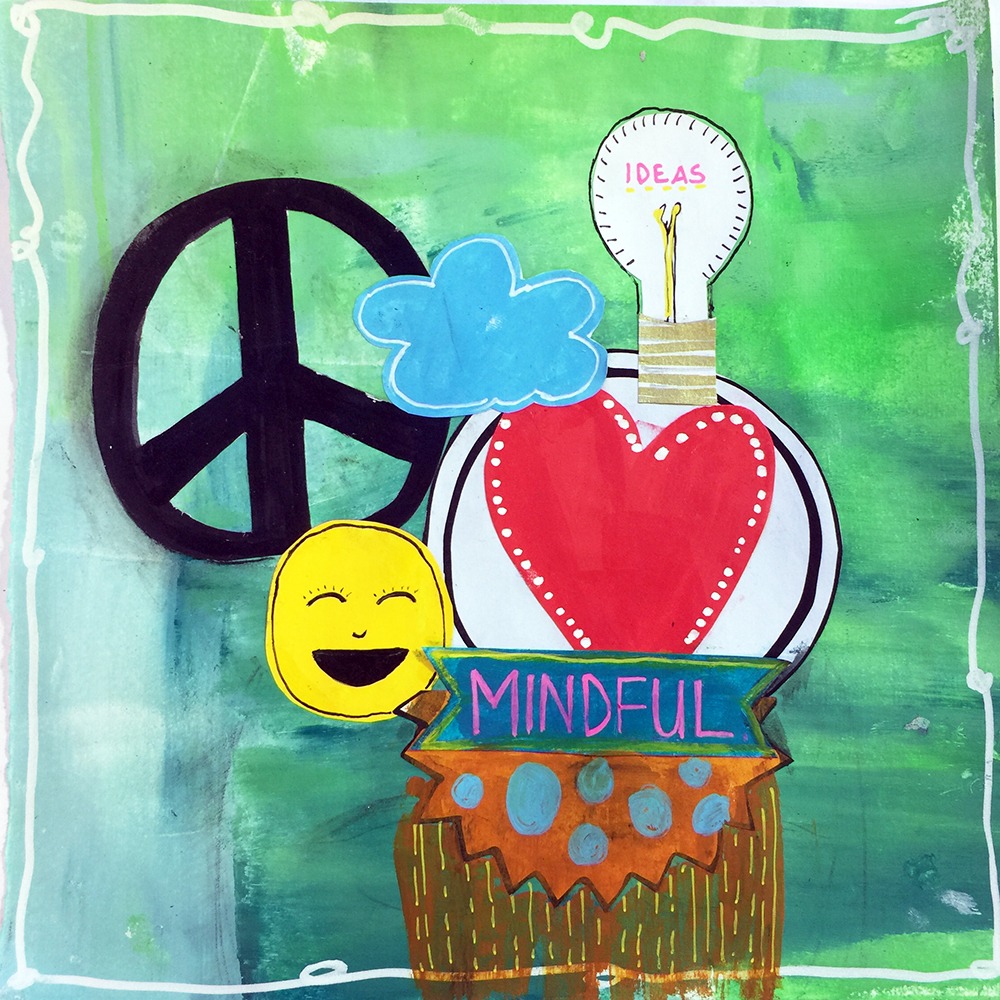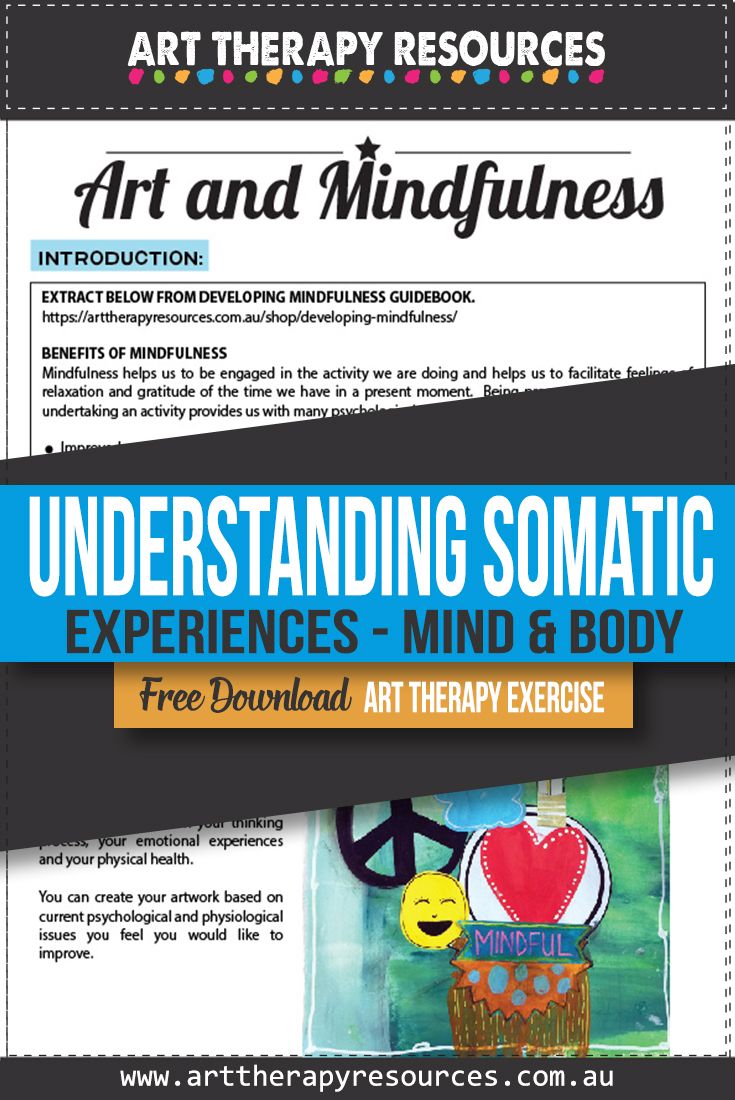THIS POST INCLUDES:
1. What is a somatic experience
2. What is Somatic Psychotherapy
3. Art Therapy and Somatic Psychotherapy
4. Free Download Art and Mindfulness Exercise
WHAT IS A SOMATIC EXPERIENCE
If you’re not familiar with the word somatic, it is defined as relating to the body. In medical terms the emphasis is heavily on the body as disconnected from the mind, however, the psychological use of the word connects the word to the body and seeks to use the somatic approach as a bridge between the mind and body.
CONNECTING THE MIND AND BODY
Somatic experience is the approach that links body awareness to psychological experiences. This is especially relevant in trauma where experiences are often suppressed emotionally and often outwardly expressed through physical symptoms.
For clients to heal from traumatic experiences, it is helpful to explore physical sensations and develop an understanding of how the body reacts to conflict, emotions, and memory recollection of traumatic events. As clients become aware of their physical sensations with regard to psychological tension, they can begin to resolve the effects of trauma with a goal to also improve health outcomes.
The physical sensations that clients can focus on include:
- Response to sounds
- Response to touch
- Response to smells
- Regulating breathing
- Total body movement
- Stretching (yoga)
All of these areas can provide clients with a pathway on how to connect their somatic experiences and psychological experiences.
COMMON PHYSICAL SYMPTOMS
Below are some of the common physical symptoms associated with difficult psychological experiences:
- Stomach pain
- Upper and lower back pain
- Pain in arms, legs, or joints
- Neck and shoulder tension
- Headaches and migraines
- Chest pain
- Dizziness and fainting
- Heart pounding/racing
- Shortness of breath
- Constipation or diarrhea
- Digestive issues
- Nausea
- Tiredness
- Trouble sleeping (getting to sleep and/or staying asleep)
- Sexual dysfunction
WHAT IS SOMATIC PSYCHOTHERAPY
DEFINITION OF SOMATIC PSYCHOTHERAPY
Somatic psychotherapy is a therapeutic approach that involves the interaction of mind, body, and emotions. In these interactions, it’s considered that the flow on effect of mind and body can be bi-directional. Physical experiences can impact psychological experiences and psychological experiences can impact physical experiences. For a client, it can sometimes become a challenge to determine whether the physical experience or psychological experience is the preceding factor.
In somatic psychotherapy, talk therapy is a common technique used to connect mind-body sensations and work towards physical and emotional healing. In addition to talk therapy, many other strategies are used to engage either the physical or mental processes in the hope of benefiting its counterpart. These can include:
- Non-verbal communication through body positions (power positions, submissive positions)
- Developing breathing patterns
- Body tension exercises
- Posture and gesture discovery
- Mindfulness techniques
- Therapeutic massage
- Facial tension release
- Stretching exercises (yoga)
- Physical exercises such as dance
Somatic psychotherapy can be beneficial to clients by helping them to develop awareness about their physical experiences in connection with their emotional and psychological experiences. People can often engage in maladaptive behavior without an understanding of why. If a client is attempting to change behaviours and heal past trauma, understanding the mind-body connection can be an integral part of this all-encompassing path.
Once clients understand their experience of the mind-body connection they can begin to implement coping techniques that will help reduce further tension and stress and help alleviate physical pain and discomfort.
ART THERAPY AND SOMATIC THERAPY
IMAGES AND PAIN
Art therapy is a natural fit for the process of somatic therapy as it seeks to explore the non-verbal experiences that we have. Physical sensations can often present as an image that can be expressed through art therapy. This can include images that depict the following descriptions of pain:
- Tight
- Sharp
- Blunt
- Piercing
- Overwhelming
- Explosive
- Stabbing
- Cutting
- Burning
- Crushing
- Gnawing
- Gripping
- Shooting
- Throbbing
These are all words that explain physical sensations and can also be depicted creatively in an artwork through images or metaphors.
ART THERAPY ACTIVITIES AND MATERIALS
Many art activities can help facilitate the exploration of feelings of pain and discomfort. These art activities can include drawing, painting, clay work, collage, and physical expression through dance.
When choosing art activities and providing art supplies, it’s important to remember that art materials may trigger physical sensations. This can include smells from art supplies for those are sensitive to smell. It can also include the physical properties of art materials that may be gritty, chalky, slimy etc.
It’s advisable to work with clients on what materials are most suitable for them. If a client has little experience with art supplies, it can be helpful to educate them on the sensory properties of each supply so the client is informed before they choose what materials to use.
Alternatively, art and craft supplies can also be used as a way of introducing different sensations to the client’s experience as a form of subtle exposure to different physical feelings. As always, the client’s perspective and experience are paramount to the choices you make as an art therapist in a session.
ART AND MINDFULNESS EXERCISE
This exercise was taken from the Developing Mindfulness guidebook that can be purchased from the store here.
ART EXERCISE:
What benefits do you think mindfulness can provide to you? Consider the impact on your thinking process, your emotional experiences and your physical health.
The below artwork is a response to the question of the benefits of mindfulness. The images used in the collage as a representation of what mindfulness symbolizes to the creator.

FREE DOWNLOAD: Art Therapy Exercise
SIGN UP below to download the FREE Mindfulness Exercise

BUILD YOUR ART THERAPY REFERENCE MATERIALS:
Pin this image to your Pinterest board.

SHARE KNOWLEDGE & PASS IT ON:
If you’ve enjoyed this post, please share it on Facebook, Twitter, Pinterest. Thank you!
